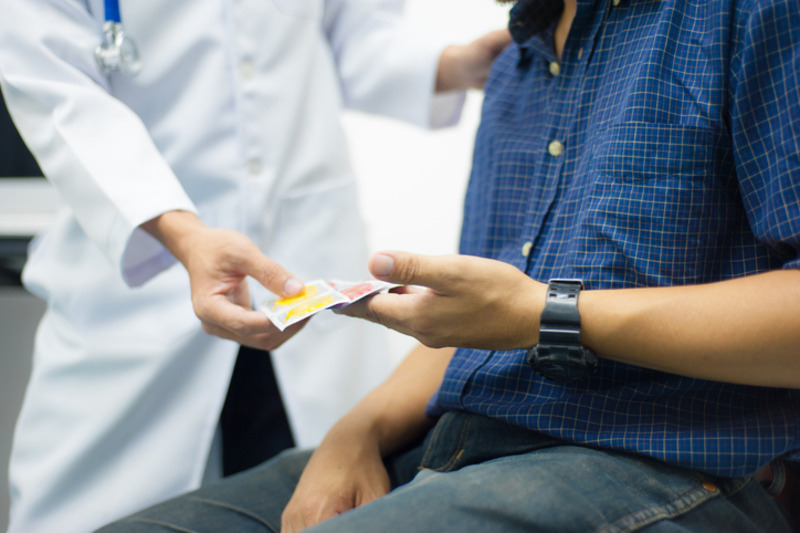
A sexually transmitted disease (STD), also known as a sexually transmitted infection (STI), can be passed through vaginal, oral, or anal sex. Anyone who has sex can be exposed to and become infected with an STI.
Using a condom from start to finish during any type of sex (i.e., vaginal, oral, or anal) can help reduce your risk of getting an STI, but even condoms are not 100% effective.
The best way to know if your sexual partner has an STI is for them to get tested. Although STIs can cause symptoms, sometimes an individual may be asymptomatic, meaning that they can be infected with the STI without showing any signs of it. Therefore, you should never assume that someone does not have an STI simply because they do not have any symptoms.
Nevertheless, there are some telltale signs of STIs to be aware of when they do cause symptoms.
Sores or blisters on the mouth or genitals.
Sores or blisters on the genitals or mouth can be caused by herpes simplex virus (HSV), or herpes. HSV-1 is known as oral herpes, and it is spread from mouth-to-mouth contact. However, in some cases, it can also cause genital herpes through oral sex. It is important to note that HSV-1 is not always considered an STI, and it is most often transmitted through nonsexual means.
HSV-2 is genital herpes. Sometimes, HSV-2 is asymptomatic, but it can cause blisters or open sores on the genitals. As they begin to heal, the sores may become more like scabs. HSV-2 can spread from one person to another even when the sores have gone away. In contrast to HSV-1, HSV-2 is most often spread through sexual contact.
Genital warts.
Genital warts can be caused by human papillomavirus (HPV), one of the most common STIs. Usually, HPV does not show any symptoms, but when it causes warts, they can show up in a few different ways. The warts can be small and greyish or flesh colored. They can grow individually or in clusters. Though known as genital warts, they can transfer to the mouth and throat of another person through oral sex.
Rash or signs of itching on the genitals or elsewhere.
Itchiness near the genitals can be caused by something as innocuous as a negative reaction to a new laundry detergent, but it can also be a sign of an STI. Also, having a rash on the palms of the hands or soles of the feet might be related to syphilis. Nonetheless, in many cases, a rash or darkening of skin in the genital region is due to fungal overgrowth (tinea cruris, or “jock itch” in men). This is probably the most common cause of genital rash and is not considered an STI.
Abnormal vaginal or penile drainage or vaginal pain with intercourse.
Discharge from the vagina is normal, but if it takes on a different color, odor, or consistency, it could be a sign of infection. Gonorrhea, chlamydia, and trichomoniasis can all cause abnormal discharge from the vagina or penis. Additionally, vaginal pain during sex can be the result of many different conditions or circumstances. Still, any new onset vaginal pain during intercourse could be related to an STI.
Infections of the throat.
Of course, many diseases can cause sore throats, not just STIs. However, if a person has swollen glands, sores in their mouth or throat, or a visible fungal infection in their mouth, these could be signs of an STI. Chlamydia, gonorrhea, herpes, HPV, and syphilis can all affect the mouth and throat.
Ongoing flu-like symptoms.
Flu symptoms such as fever, chills, sore throat, and body aches that persist could be a sign of an underlying STI like chlamydia, gonorrhea, syphilis, or HIV. If you or a partner have symptoms like this that last a long time, it is important to see a health care provider.
Key takeaways.
Again, the symptoms described above may not always appear when a person has an STI. The best way to take care of your sexual health is by practicing safe sex and getting tested for STIs when you have a new sexual partner. There are also preventative measures such as vaccines and medications available to reduce a person’s risk of becoming infected with certain STIs, and almost all STIs are curable, with the exception of herpes and HIV.
References:
Ducre, K. Medically reviewed by William Terranova, MD on September 5, 2022. (2020, September 4). How To Tell If Someone Has an STD. https://www.stdcheck.com/blog/how-to-tell-if-someone-has-an-std/
Mayo Clinic. (2022, May 5). Sexually transmitted disease (STD) symptoms. https://www.mayoclinic.org/diseases-conditions/sexually-transmitted-diseases-stds/in-depth/std-symptoms/art-20047081
You may also be interested in...
Other Popular Articles

What Is the Average Penis Size?
If you have ever wondered how your penis compares to others in terms of size, you are not alone. Many men are curious to know how their penises stack up compared to the average. Unfortunately, general curiosity can sometimes give way to full-on obsession and anxiety about penis size. This can be an unhealthy and often unnecessary fixation, especially because most men who think their penises are too small have perfectly normal-sized penises.

What Is Jelqing, and Does It Actually Work?
The term “jelqing” refers to a set of penis stretching exercises that some believe can make the penis bigger. Although the practice has gained attention and popularity in blogs and internet forums in recent years, there is no scientific evidence that it is an effective way to permanently increase the size of one’s penis. In fact, in some cases, jelqing may actually cause damage to the penis, so it is a good idea to get all the facts before setting off to try it.

What Is Sensate Focus and How Does It Work?
Sensate focus is a technique used to improve intimacy and communication between partners around sex, reduce sexual performance anxiety, and shift away from ingrained, goal-oriented sexual patterns that may not be serving a couple.

Can Sex Reduce Menstrual Cramps?
The SMSNA periodically receives and publishes ‘guest editorials.’ The current article was submitted by Mia Barnes, a freelance writer and researcher who specializes in women's health, wellness, and healthy living. She is the Founder and Editor-in-Chief of Body+Mind Magazine.
Having sex while you experience menstrual cramps is healthy and can provide significant benefits. While it might not be the first activity that comes to mind when your PMS or period cramping begins, many people enjoy sex to reduce menstrual cramps, experience increased pleasure and benefit from other advantages. Learn more about having sex while menstrual cramps are happening and how it can help your body.

How Long Does It Take the Average Man to Ejaculate?
On average, it takes a man between 5 to 7 minutes to orgasm and ejaculate during sexual intercourse.

The Effect of Regular Aerobic Exercise on Erectile Function
Erectile dysfunction (ED) is the inability to achieve or maintain an erection sufficient for satisfactory sexual activity. As men get older, their erectile functioning may naturally decline due to changes in testosterone levels, cardiovascular functioning, and the potential development of other chronic medical conditions that become more common with age.

